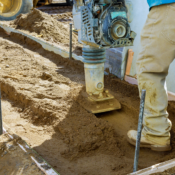This article is taken from the forthcoming Historic Buildings Ascend White Paper
If you own an historic building, whether it is a stately home or an old cottage, a standard insurance policy from a general insurance provider will fall well short of expectations if you need to make a claim. If your building is also listed, it is protected by law, limiting repair options and making some higher costs unavoidable: it is the responsibility of the owner to insure it properly. If you are considering restoration or alteration work, make sure you set yourself up with watertight insurance from the outset. At Ascend we are able to provide a stand alone insurance product designed for buildings renovations -
Renovate.
CHOOSING A SUITABLE INSURANCE POLICY
It does pay to use a specialist insurance broker who can provide advice about the choice of insurer, negotiate better premium rates and cover, and will usually arrange a 'risk management' appraisal. They will also think ahead to issues which will come up if the property needs to be repaired, altered or extended.
Building value - the difference between 'market' value and 'reinstatement' value is crucial for buildings.
You need to determine how much it would cost to rebuild the entire building using like materials and methods of construction. A cursory note of the exterior construction is really not sufficient to calculate the rebuilding cost: from the outside, a building may appear to date from the 18th century, but the inner timber structure may be 15th century. Special features could be overlooked, such as fireplace mantles, plaster mouldings, carved timber panelling. At Ascend the insurers that we recommend provide specialist appraisers.
Cover for repairs - repair contracts of substantial historic buildings can be long and complicated, giving rise to many extra costs. The standard 'cost per square metre' tables used by non-specialist insurers and mortgage company surveyors to calculate rebuilding costs are simply not up to the job as far as historic buildings are concerned, especially if authentic materials are required. The Association of British Insurers advises that these tables are suitable only for houses of 'average quality finish' and that if a pre-1920 house needs be reinstated to its original style, a professional valuation is required.
A CASE IN POINT
A Georgian home in the Midlands was converted into seven units and insured under a standard policy for £7 million. Moving to a specialist insurer who conducted a risk management appraisal, the residents discovered that the cost of rebuilding the property would have been over £15 million. In the event of a fire, the residents could have suffered a financial loss of over £8m, which would NOT BE PAID by the insurer. The revised policy offered double the cover for only 25 per cent extra premium. |
WHEN YOU COME TO REPAIRS AND ALTERATIONS
Having decided on the new wing to be added to the property, or renovation project to be undertaken, talk to your insurer about extending your cover for the works.
Some insurers reserve the right to refuse cover for works over £75,000, or where a
JCT Minor Works 6.3b contract (the standard contract between builder and client) has not been signed. Others will happily re-insure if the paperwork is in place. For example, Chubb Insurance will ask you to complete a questionnaire providing details such as the name of the contractor, their insurers and the scope of their insurance policy (the amount of their public liability cover, and the limit of indemnity), as well as a full description of works to be carried out. They will also need to know the contract value, contract period, details of security at the site, fire protection during the works and whether a JCT Clause is applicable.
If the property is uninhabited during the works, extra theft cover may need to be put in place. If the property is open to the public, the owner's public liability cover will need reviewing, too.
WHO DOES WHAT?
The parties involved in the building works will usually be co-ordinated by an architect or surveyor who will oversee the project. They will tender the work out to trusted building contractors and craftsmen. The choice of contractors is important as specialist materials and skills may be required to achieve a proper repair, and a poor job could affect the market value of the property. If the work is part of an insurance claim, most non-specialist insurers will insist that a building contractor from their own panel is used, but insurers such as Independent, Chubb and Hiscox allow their clients to use the most appropriate craftsmen for the repair work.
| Who is liable for what? |
| RISK |
RESPONSIBILITY |
| Existing Property |
Owner |
| Works in progress |
Owner |
| Negligent damage |
Contractor's public liability |
The architect/surveyor will probably use the JCT Minor Works 6.3b contract conditions to form the basis of the contract between you and the builder. This usually places the onus on the owner as the employer to insure against material damage to the project - hence the need to brief the insurance company fully. You need an insurer and broker who understand these contract conditions.
This onus on the property owner is the subject of some debate among insurers, and may change in the future so that the contractor becomes responsible for the works' insurance.
The main contractor has a responsibility to ensure that no damage is caused to the property and must maintain adequate public liability insurance. The indemnity limit should reflect the maximum potential loss. For smaller homes an indemnity limit of £2 million will be adequate; for larger properties, the sum insured will need to be increased accordingly. Any sub-contractors who are employed must also carry the same indemnity limit and their insurance details should be verified before they start work.
Many claims arise from 'hot works'. Blowtorches and welding equipment for example, if left smouldering, may start a blaze and all naked flames have been banned from some historic properties. Where works are permissible all reputable contractors should have a hot works permit that requires them to monitor an area worked on for at least an hour after the work has been completed. Check that the contractor or any sub-contractor does not have a heat exclusion in their liability policy, as this will affect your insurer's recovery rights.
If the building being worked on is close to other people's property, the owner should consider extending the contractor's liability insurance to cover non-negligent damage that may be caused during the works; the JCT 6.5.1 contract.
Our consultants are available today to provide you with advice when dealing with historic buildings.
Contact us now to receive a copy of the forthcoming white paper on Historic Buildings Insurance.
01245 449060
info@ascendbrokingold.co.uk






